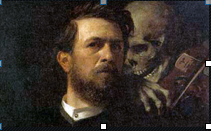Legends of John O’Kent
The legendary John o’ Kent or Jacky Kent is said to have lived in the Herefordshire/Monmouthshire borders at an unspecified medieval date. He first appears in print in Anthony Munday’s play John a Kent and John a Cumber which is dated around 1590, in which he appears as an old hermit with supernatural powers. The most likely characters upon whom the legend is built are the Welsh Franciscan friar Dr John Gwent or Kent, who died in 1348, Dr John Kent of Caerleon, an astronomer, who wrote a treatise on witchcraft in the thirteenth century, and John Kent, a Robin Hood-like figure who roamed the Welsh Marches.
The Franciscan friar, John of Kentchurch, was not only an accomplished writer, poet and Welsh bard, but he was a scientist of note, seemingly able to perform ‘miraculous feats’ by his knowledge of nature.
Many of the myths of John of Kent revolve around his outwitting the devil, having on the other hand sold his soul to the devil as a young boy in order to have supernatural power or power to use the devil as his servant.
Sometimes his power was used for public good. Locally, perhaps the most well-known one is associated with a bridge over the Monnow between Kentchurch and Grosmont. The tale is told that with the help of the devil the bridge was built in a single night, but the pact included a promise that the Devil could have the soul of the first to cross it.
With the bridge complete, the devil was impatient that he should have his reward for keeping his side of the bargain before he had to disappear as daylight approached. He encouraged Jack to be the first to cross his new bridge. But, not to be outwitted, spotting a starving dog nearby, Jack tempted it with a bone. As it came bounding to him, Jack threw the bone across the bridge and the dog chased after it. As the cock crowed the devil had to accept his only reward for his effort would be the hapless dog…
Other stories of beating the devil relate to the crops. On one occasion passing a field when seeds were sown, he offered Satan the choice, at harvest-time, of having half the crop: he offered the tops or the bottoms. The devil decided to take the tops. When the harvest came he discovered it was a field of turnips. So when next he was made the same offer, he chose the bottom half, only to discover at harvest-time that this year’s crop was wheat.
Jack o’ Kent is fabled to have kept great horses with magical powers of flight in the stables at Kentchurch Court. The story goes that one day he set off at dawn with a mince pie to take to the King in London. He got to London in time for breakfast with the pie still hot – though he had lost his garter en route, caught on the weathervane of a church as he bounded over it. Another story of his control over the animal kingdom concerns a time he was employed by a farmer as a crow-scarer. Jack decided that he wanted to go to the fair that had arrived in town, so he called together all the crows and put them into an old barn, with no roof on it… and there they stayed. At the fair unfortunately he met the farmer for whom he was working, who angrily took him back to the farm. But Jack led him to the barn: there were all of the crows, despite the lack of roof they were unable to escape.
In other anecdotes, Jack is portrayed as a giant. One day, it is said, he jumped off the Sugar Loaf Mountain onto the Skirrid, and there’s his heel mark in the Skirrid to this day. Another that He and the devil met on Trelleck Beacon and had a throwing match. Jack threw first, then on his turn, the devil threw further. When Jack had his second throw, he threw further still and the devil storm off in high dudgeon. This accounts for the eponymous standing-stones at Trelleck.
